Effect of Piezoelectric BaTiO3 Filler on Mechanical and Magnetoelectric Properties of Zn0.25Co0.75Fe2O4/PVDF-TrFE Composites
Abstract
1. Introduction
2. Materials and Methods
2.1. Synthesis and Properties of the Filler Particles
2.2. Fabrication of Magnetoelectric Nanocomposites (NCs)
- Preparation of the base solution (Figure 1a).
- 2.
- Adding fillers (Figure 1b).
- 3.
- Blending (Figure 1c).
- 4.
- Spreading (Figure 1d).
- 5.
- Alignment in a magnetic field (Figure 1e).
- 6.
- Evaporation (Figure 1f).
- PVDF-TrFE—pure PVDF-TrFE polymer;
- BTO/PVDF-TrFE—a composite filled with 5 wt.%. of BTO particles;
- ZCFO/PVDF-TrFE—a composite filled with 15 wt.% of ZCFO particles;
- BTO/ZCFO/PVDF-TrFE—a composite filled with 5 wt.% of BTO and 15 wt.% of ZCFO particles.
2.3. Structural Characterization (X-ray Computer Tomography, XRD, SEM-EDX)
2.4. Magnetic Characterization (VSM, FORC)
2.5. Atomic and Magnetic Force Microscopy (AFM, MFM) and Magnetoelectric Properties
3. Results and Discussion
3.1. Structural Characterization
3.2. Magnetic Characterization
3.3. Mechanical, Surface and Magnetoelectric Properties
4. Conclusions
Supplementary Materials
Author Contributions
Funding
Data Availability Statement
Acknowledgments
Conflicts of Interest
References
- Roseti, L.; Parisi, V.; Petretta, M.; Cavallo, C.; Desando, G.; Bartolotti, I.; Grigolo, B. Scaffolds for Bone Tissue Engineering: State of the art and new perspectives. Mater. Sci. Eng. C 2017, 78, 1246–1262. [Google Scholar] [CrossRef] [PubMed]
- Ye, G.; Bao, F.; Zhang, X.; Song, Z.; Liao, Y.; Fei, Y.; Bunpetch, V.; Heng, B.C.; Shen, W.; Liu, H.; et al. Nanomaterial-based scaffolds for bone tissue engineering and regeneration. Nanomedicine 2020, 15, 1995–2017. [Google Scholar] [CrossRef] [PubMed]
- Del Bakhshayesh, A.R.; Asadi, N.; Alihemmati, A.; Nasrabadi, H.T.; Montaseri, A.; Davaran, S.; Saghati, S.; Akbarzadeh, A.; Abedelahi, A. An overview of advanced biocompatible and biomimetic materials for creation of replacement structures in the musculoskeletal systems: Focusing on cartilage tissue engineering. J. Biol. Eng. 2019, 13, 85. [Google Scholar] [CrossRef] [PubMed]
- Yang, Y.; Wang, K.; Gu, X.; Leong, K.W. Biophysical Regulation of Cell Behavior—Cross Talk between Substrate Stiffness and Nanotopography. Engineering 2017, 3, 36–54. [Google Scholar] [CrossRef]
- Khare, D.; Basu, B.; Dubey, A.K. Electrical stimulation and piezoelectric biomaterials for bone tissue engineering applications. Biomaterials 2020, 258, 120280. [Google Scholar] [CrossRef]
- Engler, A.J.; Sen, S.; Sweeney, H.L.; Discher, D.E. Matrix Elasticity Directs Stem Cell Lineage Specification. Cell 2006, 126, 677–689. [Google Scholar] [CrossRef]
- Moe, A.A.K.; Suryana, M.; Marcy, G.; Lim, S.K.; Ankam, S.; Goh, J.Z.W.; Jin, J.; Teo, B.K.K.; Law, J.B.K.; Low, H.Y.; et al. Microarray with Micro- and Nano-topographies Enables Identification of the Optimal Topography for Directing the Differentiation of Primary Murine Neural Progenitor Cells. Small 2012, 8, 3050–3061. [Google Scholar] [CrossRef]
- Genchi, G.G.; Ceseracciu, L.; Marino, A.; Labardi, M.; Marras, S.; Pignatelli, F.; Bruschini, L.; Mattoli, V.; Ciofani, G. P(VDF-TrFE)/BaTiO 3 Nanoparticle Composite Films Mediate Piezoelectric Stimulation and Promote Differentiation of SH-SY5Y Neuroblastoma Cells. Adv. Health Mater. 2016, 5, 1808–1820. [Google Scholar] [CrossRef]
- Hoop, M.; Chen, X.-Z.; Ferrari, A.; Mushtaq, F.; Ghazaryan, G.; Tervoort, T.; Poulikakos, D.; Nelson, B.; Pané, S. Ultrasound-mediated piezoelectric differentiation of neuron-like PC12 cells on PVDF membranes. Sci. Rep. 2017, 7, 4028. [Google Scholar] [CrossRef]
- Ribeiro, S.; Gomes, A.; Etxebarria, I.; Lanceros-Mendez, S.; Ribeiro, C. Electroactive biomaterial surface engineering effects on muscle cells differentiation. Mater. Sci. Eng. C 2018, 92, 868–874. [Google Scholar] [CrossRef]
- Abazari, M.F.; Hosseini, Z.; Karizi, S.Z.; Norouzi, S.; Faskhoudi, M.A.; Saburi, E.; Enderami, S.E.; Ardeshirylajimi, A.; Mohajerani, H. Different osteogenic differentiation potential of mesenchymal stem cells on three different polymeric substrates. Gene 2020, 740, 144534. [Google Scholar] [CrossRef]
- Oh, S.; Brammer, K.S.; Li, Y.S.J.; Teng, D.; Engler, A.J.; Chien, S. Stem cell fate dictated solely by altered nanotube dimension. Proc. Natl. Acad. Sci. USA 2009, 106, 2130–2135. [Google Scholar] [CrossRef] [PubMed]
- Alaribe, F.N.; Manoto, S.L.; Motaung, S.C.K.M. Scaffolds from biomaterials: Advantages and limitations in bone and tissue engineering. Biologia 2016, 71, 353–366. [Google Scholar] [CrossRef]
- Chocholata, P.; Kulda, V.; Babuska, V. Fabrication of Scaffolds for Bone-Tissue Regeneration. Materials 2019, 12, 568. [Google Scholar] [CrossRef] [PubMed]
- Fukada, E. Piezoelectricity of biopolymers. Biorheology 1995, 32, 593–609. [Google Scholar] [CrossRef] [PubMed]
- Fukada, E.; Yasuda, I. Piezoelectric Effects in Collagen. Jpn. J. Appl. Phys. 1964, 3, 117–121. [Google Scholar] [CrossRef]
- Chen, Y.; Mak, A.F.; Wang, M.; Li, J.; Wong, M. PLLA scaffolds with biomimetic apatite coating and biomimetic apatite/collagen composite coating to enhance osteoblast-like cells attachment and activity. Surf. Coat. Technol. 2006, 201, 575–580. [Google Scholar] [CrossRef]
- Prabhakaran, M.P.; Venugopal, J.; Ramakrishna, S. Electrospun nanostructured scaffolds for bone tissue engineering. Acta Biomater. 2009, 5, 2884–2893. [Google Scholar] [CrossRef]
- Ivanov, M.; Silibin, M.; Khomchenko, V.; Nikitin, T.; Kalinin, A.; Karpinsky, D.; Bdikin, I.; Polyakov, V.; Fausto, R.; Paixão, J. Strong impact of LiNbO3 fillers on local electromechanical and electrochemical properties of P(VDF-TrFe) polymer disclosed via scanning probe microscopy. Appl. Surf. Sci. 2018, 470, 1093–1100. [Google Scholar] [CrossRef]
- Spaldin, N.A.; Fiebig, M. The Renaissance of magnetoelectric multiferroics. Science 2005, 309, 391–392. [Google Scholar] [CrossRef]
- Hu, J.-M.; Nan, T.; Sun, N.X.; Chen, L.-Q. Multiferroic magnetoelectric nanostructures for novel device applications. MRS Bull. 2015, 40, 728–735. [Google Scholar] [CrossRef]
- Wang, P.; Zhang, E.; Toledo, D.; Smith, I.T.; Navarrete, B.; Furman, N.; Hernandez, A.F.; Telusma, M.; McDaniel, D.; Liang, P.; et al. Colossal Magnetoelectric Effect in Core–Shell Magnetoelectric Nanoparticles. Nano Lett. 2020, 20, 5765–5772. [Google Scholar] [CrossRef] [PubMed]
- Kopyl, S.; Surmenev, R.; Surmeneva, M.; Fetisov, Y.; Kholkin, A. Magnetoelectric effect: Principles and applications in biology and medicine—A review. Mater. Today Bio 2021, 12, 100149. [Google Scholar] [CrossRef]
- Martins, P.; Lanceros-Méndez, S. Polymer-Based Magnetoelectric Materials. Adv. Funct. Mater. 2013, 23, 3371–3385. [Google Scholar] [CrossRef]
- Martins, P.; Lopes, A.C.; Lanceros-Mendez, S. Electroactive phases of poly(vinylidene fluoride): Determination, processing and applications. Prog. Polym. Sci. 2014, 39, 683–706. [Google Scholar] [CrossRef]
- He, F.; Sarkar, M.; Lau, S.; Fan, J.; Chan, L.H. Preparation and characterization of porous poly(vinylidene fluoride-trifluoroethylene) copolymer membranes via electrospinning and further hot pressing. Polym. Test. 2011, 30, 436–441. [Google Scholar] [CrossRef]
- Ram, F.; Kaviraj, P.; Pramanik, R.; Krishnan, A.; Shanmuganathan, K.; Arockiarajan, A. PVDF/BaTiO films with nanocellulose impregnation: Investigation of structural, morphological and mechanical properties. J. Alloys Compd. 2020, 823. [Google Scholar] [CrossRef]
- Meng, N.; Mao, R.; Tu, W.; Odolczyk, K.; Zhang, Q.; Bilotti, E.; Reece, M.J. Crystallization kinetics and enhanced dielectric properties of free standing lead-free PVDF based composite films. Polymer 2017, 121, 88–96. [Google Scholar] [CrossRef]
- Supriya, S.; Kumar, L.; Kar, M. Optimization of dielectric properties of PVDF-CFO nanocomposites. Polym. Compos. 2018, 40, 1239–1250. [Google Scholar] [CrossRef]
- Gutiérrez, J.; Martins, P.; Gonçalves, R.; Sencadas, V.; Lasheras, A.; Lanceros-Mendez, S.; Barandiarán, J. Synthesis, physical and magnetic properties of BaFe12O19/P(VDF-TrFE) multifunctional composites. Eur. Polym. J. 2015, 69, 224–231. [Google Scholar] [CrossRef]
- Sencadas, V.; Martins, P.; Pitães, A.; Benelmekki, M.; Ribelles, J.L.G.; Lanceros-Mendez, S. Influence of Ferrite Nanoparticle Type and Content on the Crystallization Kinetics and Electroactive Phase Nucleation of Poly(vinylidene fluoride). Langmuir 2011, 27, 7241–7249. [Google Scholar] [CrossRef] [PubMed]
- Liu, M.R. Fabrication, Characterization and Investigation of Novel PVDF/ZnO and PVDF-TrFE/ZnO Nanocomposites with Enhanced β-Phase and Dielectricity. Mater. Sci. Forum 2020, 977, 277–282. [Google Scholar] [CrossRef]
- Ribeiro, C.; Costa, C.M.; Correia, D.M.; Nunes-Pereira, J.; Oliveira, J.; Martins, P.; Gonçalves, R.; Cardoso, V.F.; Lanceros-Méndez, S. Electroactive poly(vinylidene fluoride)-based structures for advanced applications. Nat. Protoc. 2018, 13, 681–704. [Google Scholar] [CrossRef]
- Mammeri, F. Nanostructured flexible PVDF and fluoropolymer-based hybrid films. Front. Nanosci. 2019, 14, 67–101. [Google Scholar] [CrossRef]
- Zhang, X.; Zhang, C.; Lin, Y.; Hu, P.; Shen, Y.; Wang, K.; Meng, S.; Chai, Y.; Dai, X.; Liu, X.; et al. Nanocomposite Membranes Enhance Bone Regeneration Through Restoring Physiological Electric Microenvironment. ACS Nano 2016, 10, 7279–7286. [Google Scholar] [CrossRef]
- Lopes, H.B.; Santos, T.D.S.; De Oliveira, F.S.; Freitas, G.P.; De Almeida, A.L.; Gimenes, R.; Rosa, A.L.; Beloti, M.M. Poly(vinylidene-trifluoroethylene)/barium titanate composite for in vivo support of bone formation. J. Biomater. Appl. 2013, 29, 104–112. [Google Scholar] [CrossRef]
- Gimenes, R.; Zaghete, M.A.; Bertolini, M.; Varela, J.A.; Coelho, L.O.; Silva, J.N.F. Composites PVDF-TrFE/BT used as bioactive membranes for enhancing bone regeneration. In Proceedings of the Smart Structures and Materials 2004: Electroactive Polymer Actuators and Devices (EAPAD), San Diego, CA, USA, 14–18 March 2004; SPIE: London, UK, 2004; Volume 5385, pp. 539–547. [Google Scholar] [CrossRef]
- Gilicinski, A.G.; Hegedus, C.R. Mechanical Studies of Film Formation in Waterborne Coatings by Atomic Force Microscopy. J. Biomater. Appl. 1996, 29, 286–300. [Google Scholar] [CrossRef]
- Tsou, A.H.; Yablon, D.G. Atomic Force Microscopy of Polymers. In Scanning Probe Microscopy in Industrial Applications: Nanomechanical Characterization; Wiley: Hoboken, NJ, USA, 2014; Chapter 9. [Google Scholar] [CrossRef]
- Nakajima, K.; Wang, D.; Nishi, T. AFM Characterization of Polymer Nanocomposites. In Characterization Techniques for Polymer Nanocomposites; Wiley: Hoboken, NJ, USA, 2012. [Google Scholar] [CrossRef]
- Omelyanchik, A.; Antipova, V.; Gritsenko, C.; Kolesnikova, V.; Murzin, D.; Han, Y.; Turutin, A.; Kubasov, I.; Kislyuk, A.; Ilina, T.; et al. Boosting Magnetoelectric Effect in Polymer-Based Nanocomposites. Nanomaterials 2021, 11, 1154. [Google Scholar] [CrossRef]
- Omelyanchik, A.; Levada, K.; Pshenichnikov, S.; Abdolrahim, M.; Baricic, M.; Kapitunova, A.; Galieva, A.; Sukhikh, S.; Astakhova, L.; Antipov, S.; et al. Green Synthesis of Co-Zn Spinel Ferrite Nanoparticles: Magnetic and Intrinsic Antimicrobial Properties. Materials 2020, 13, 5014. [Google Scholar] [CrossRef]
- Cannas, C.; Falqui, A.; Musinu, A.; Peddis, D.; Piccaluga, G. CoFe2O4 nanocrystalline powders prepared by citrate-gel methods: Synthesis, structure and magnetic properties. J. Nanopart. Res. 2006, 8, 255–267. [Google Scholar] [CrossRef]
- Shilkina, L.; Talanov, M.; Shevtsova, S.; Grin’, P.; Kozakov, A.; Dudkina, S.; Nikol’Skii, A.; Reznichenko, L. Isomorphism problems in lead-barium titanate. J. Alloys Compd. 2020, 829, 154589. [Google Scholar] [CrossRef]
- Cimpoesu, D.; Dumitru, I.; Stancu, A. doFORC tool for calculating first-order reversal curve diagrams of noisy scattered data. J. Appl. Phys. 2019, 125, 023906. [Google Scholar] [CrossRef]
- Martínez-García, J.; Rivas, M. FORC analysis of ferro-ferromagnetic exchange bias in nanocrystalline ribbons. Phys. B Condens. Matter 2016, 486, 84–87. [Google Scholar] [CrossRef]
- Stancu, A.; Pike, C.; Stoleriu, L.; Postolache, P.; Cimpoesu, D. Micromagnetic and Preisach analysis of the First Order Reversal Curves (FORC) diagram. J. Appl. Phys. 2003, 93, 6620–6622. [Google Scholar] [CrossRef]
- Rivas, M.; Martínez-García, J.C.; Škorvánek, I.; Marcin, J.; Švec, P.; Gorria, P. Magnetostatic interaction in soft magnetic bilayer ribbons unambiguously identified by first-order reversal curve analysis. Appl. Phys. Lett. 2015, 107, 132403. [Google Scholar] [CrossRef]
- Vaganov, M.; Linke, J.; Odenbach, S.; Raikher, Y. Model FORC diagrams for hybrid magnetic elastomers. J. Magn. Magn. Mater. 2017, 431, 130–133. [Google Scholar] [CrossRef]
- Linke, J.M.; Borin, D.Y.; Odenbach, S. First-order reversal curve analysis of magnetoactive elastomers. RSC Adv. 2016, 6, 100407–100416. [Google Scholar] [CrossRef]
- Schliephake, M.; Linke, J.M.; Odenbach, S. Magnetic characterization of magnetoactive elastomers containing magnetic hard particles using first-order reversal curve analysis. Phys. Sci. Rev. 2021. [Google Scholar] [CrossRef]
- Valdez-Grijalva, M.A.; Muxworthy, A.R. First-order reversal curve (FORC) diagrams of nanomagnets with cubic magnetocrystalline anisotropy: A numerical approach. J. Magn. Magn. Mater. 2019, 471, 359–364. [Google Scholar] [CrossRef]
- Stan, G.; King, S.W. Atomic force microscopy for nanoscale mechanical property characterization. J. Vac. Sci. Technol. B 2020, 38, 060801. [Google Scholar] [CrossRef]
- Gundermann, T.; Odenbach, S. Investigation of the motion of particles in magnetorheological elastomers by X-μCT. Smart Mater. Struct. 2014, 23. [Google Scholar] [CrossRef]
- Harrison, R.; Feinberg, J.M. FORCinel: An improved algorithm for calculating first-order reversal curve distributions using locally weighted regression smoothing. Geochem. Geophys. Geosyst. 2008, 9, Q05016. [Google Scholar] [CrossRef]
- Kolesnikova, V.; Martínez-García, J.; Rodionova, V.; Rivas, M. Study of bistable behaviour in interacting Fe-based microwires by first order reversal curves. J. Magn. Magn. Mater. 2020, 508, 166857. [Google Scholar] [CrossRef]
- Gilbert, D.; Zimanyi, G.T.; Dumas, R.; Winklhofer, M.; Gomez, A.; Eibagi, N.; Vicent, J.L.; Liu, K. Quantitative Decoding of Interactions in Tunable Nanomagnet Arrays Using First Order Reversal Curves. Sci. Rep. 2014, 4, 4204. [Google Scholar] [CrossRef] [PubMed]
- Roberts, A.P.; Pike, C.R.; Verosub, K.L. First-order reversal curve diagrams: A new tool for characterizing the magnetic properties of natural samples. J. Geophys. Res. Earth Surf. 2000, 105, 28461–28475. [Google Scholar] [CrossRef]
- Kolesnikova, V.; Makarova, L.; Omelyanchik, A.; Sobolev, K.; Isaev, D.; Alekhina, I.; Komlev, A.; Rodionova, V.; Perov, N. Magnetoactive elastomers based on ferromagnetic and ferroelectric particles: A FORC approach. J. Magn. Magn. Mater. 2022, 558, 169506. [Google Scholar] [CrossRef]
- Mendes, S.F.S.; Costa, C.M.; Caparros, C.; Sencadas, V.; Lanceros-Méndez, S. Effect of filler size and concentration on the structure and properties of poly(vinylidene fluoride)/BaTiO3 nanocomposites. J. Mater. Sci. 2011, 47, 1378–1388. [Google Scholar] [CrossRef]
- Lu, S.G.; Rozic, B.; Kutnjiak, Z.; Zhang, Q.M. Electrocaloric Effect in Ferroelectric P(VDF-TrFE) Copolymers. Integr. Ferroelectr. 2012, 125, 176–185. [Google Scholar] [CrossRef]
- Martins, P.; Kolen’Ko, Y.V.; Rivas, J.; Lanceros-Mendez, S. Tailored Magnetic and Magnetoelectric Responses of Polymer-Based Composites. ACS Appl. Mater. Interfaces 2015, 7, 15017–15022. [Google Scholar] [CrossRef]
- Fernandes, M.M.; Correia, D.M.; Ribeiro, C.; Castro, N.; Correia, V.M.G.; Lanceros-Mendez, S. Bioinspired Three-Dimensional Magnetoactive Scaffolds for Bone Tissue Engineering. ACS Appl. Mater. Interfaces 2019, 11, 45265–45275. [Google Scholar] [CrossRef]
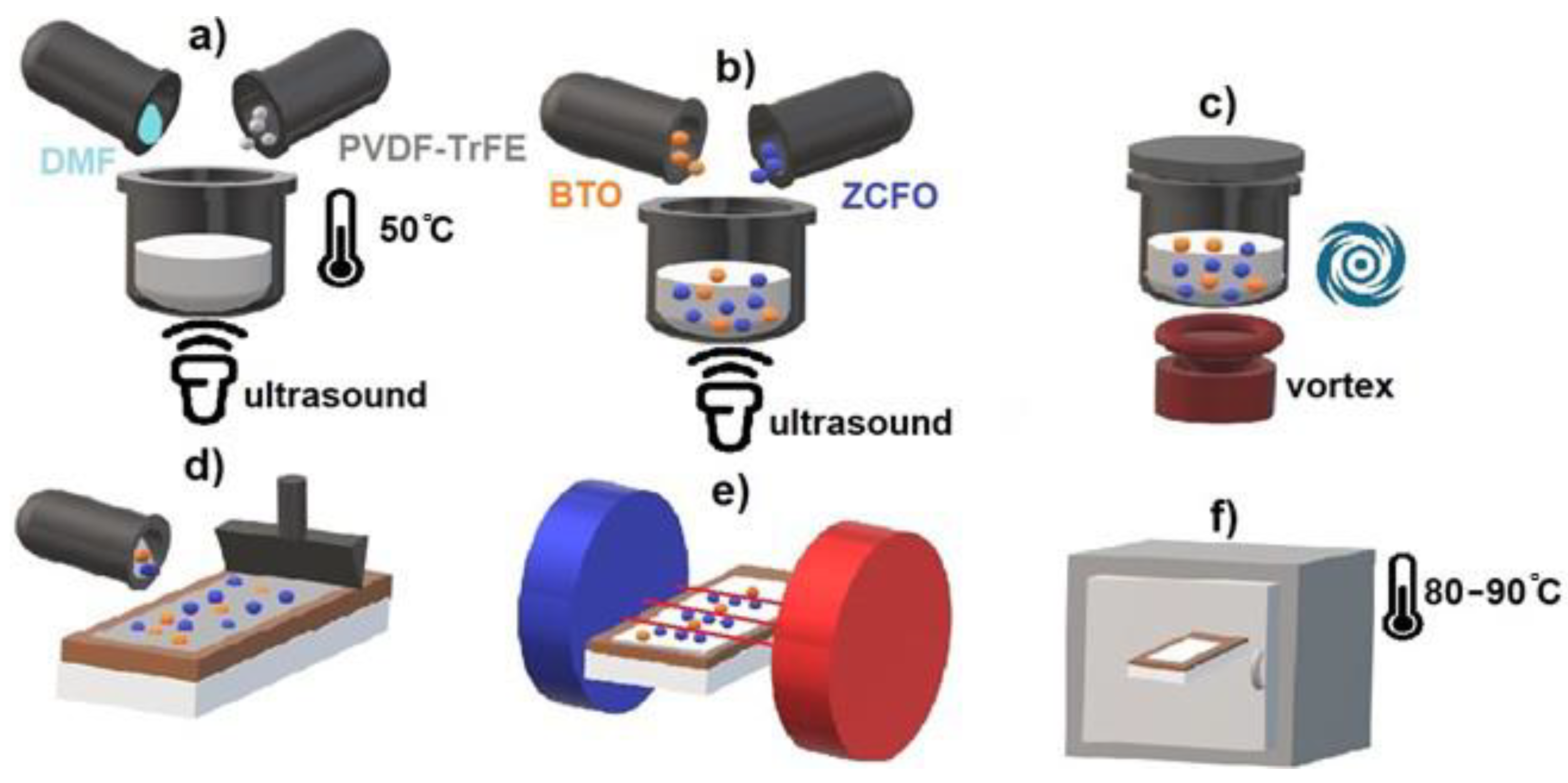
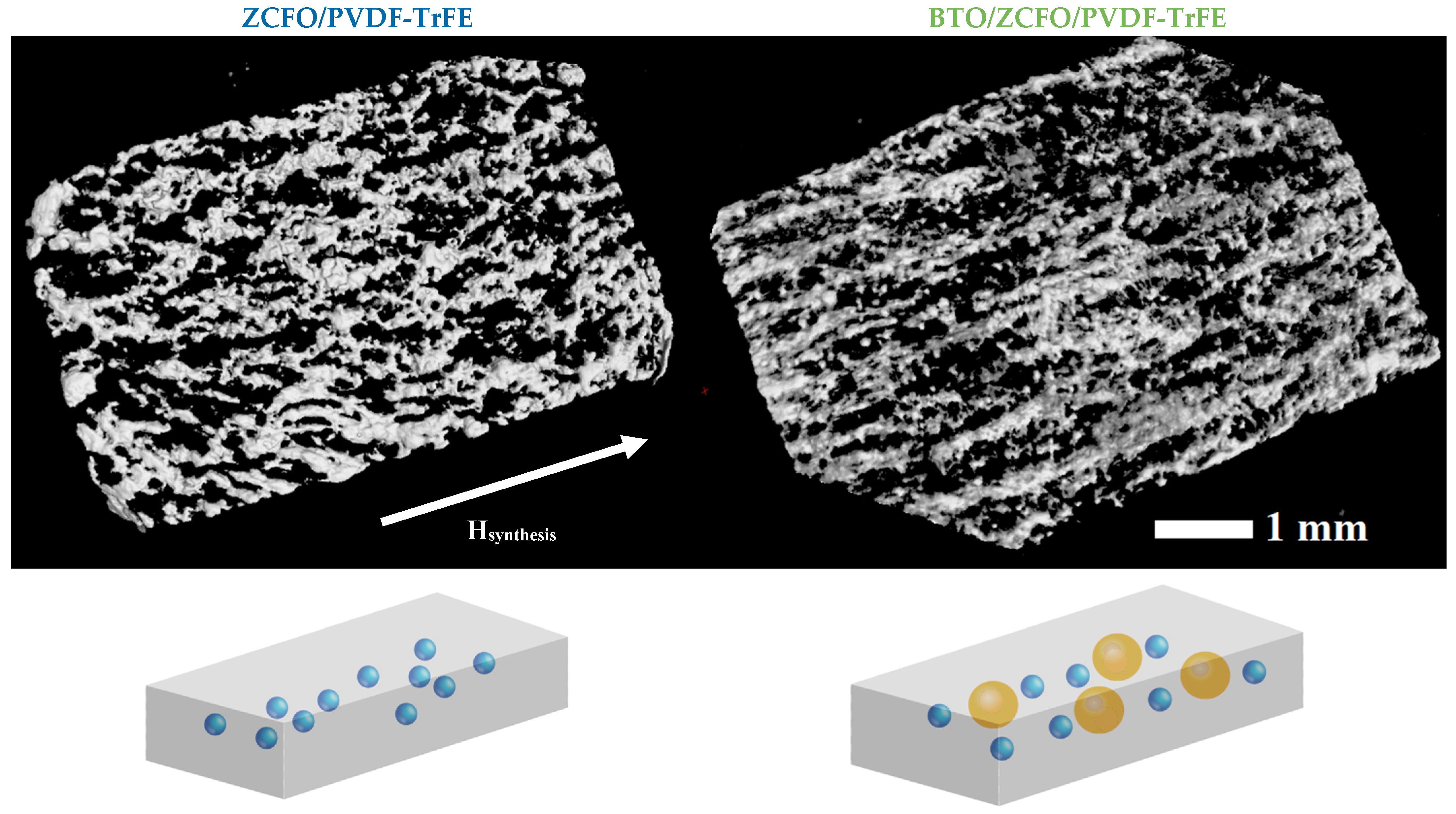
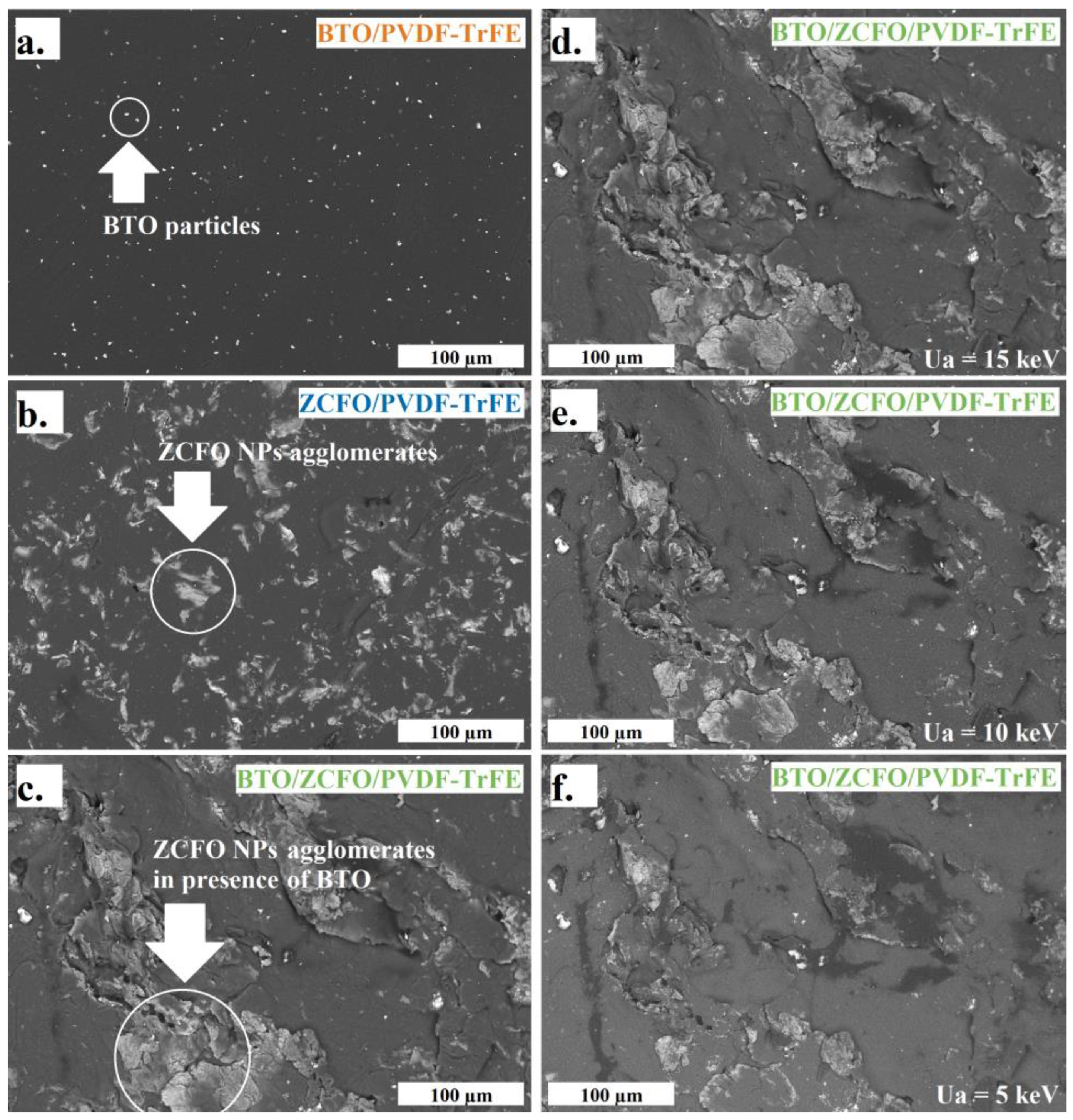
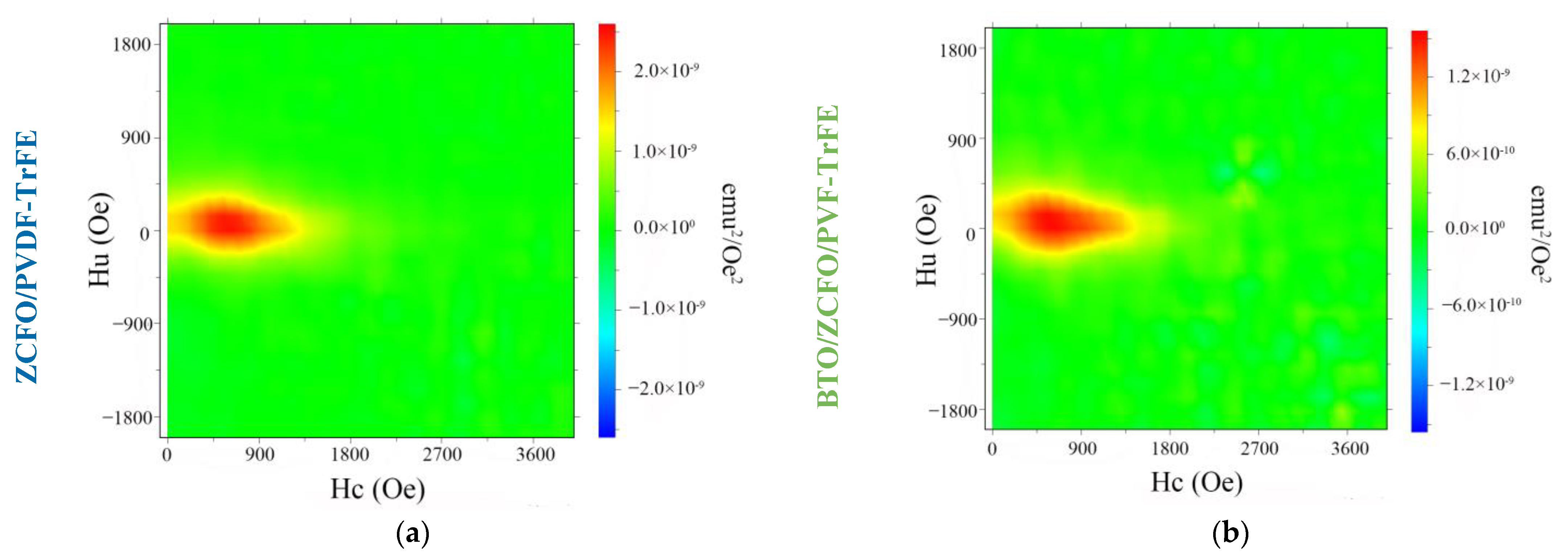
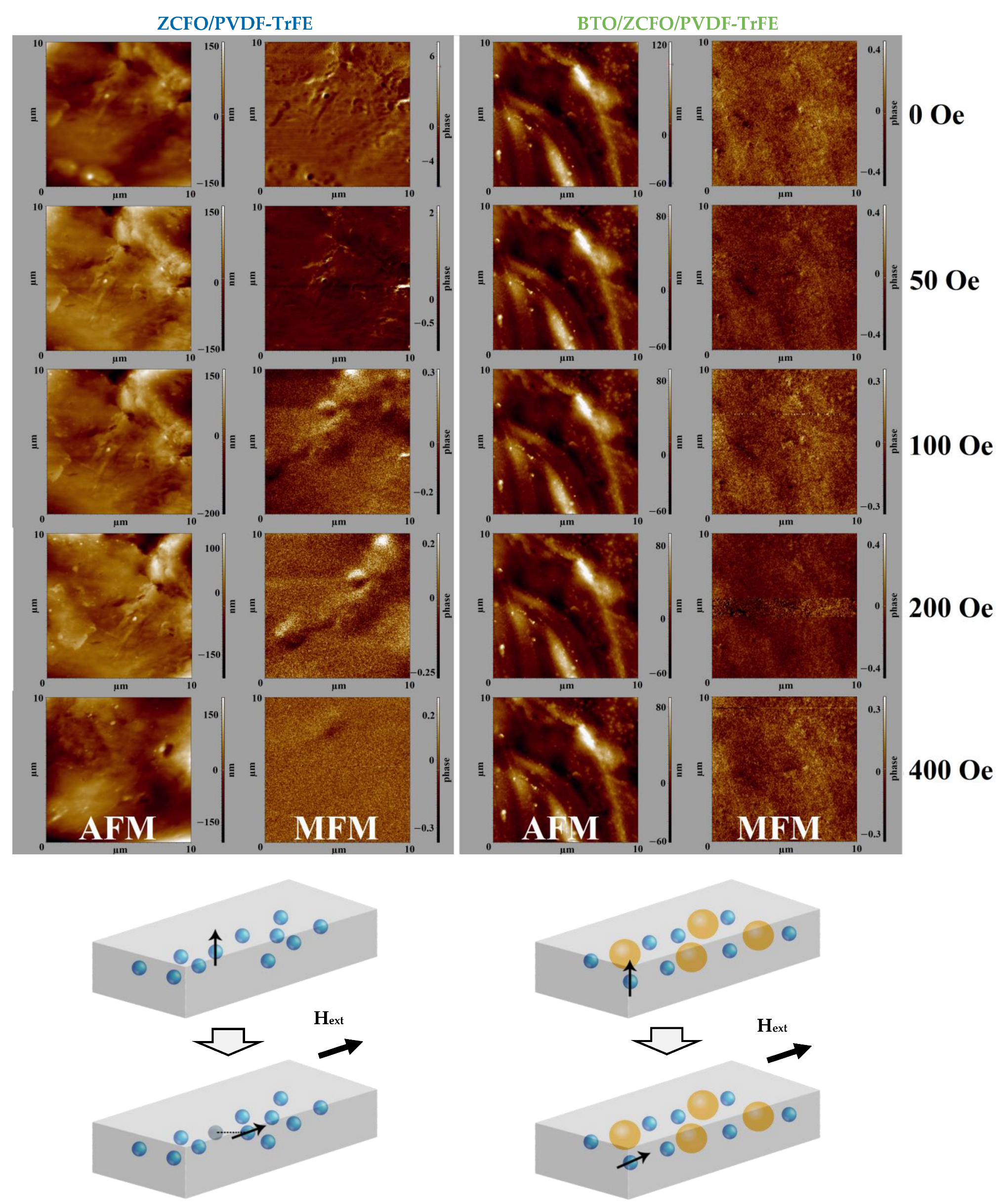
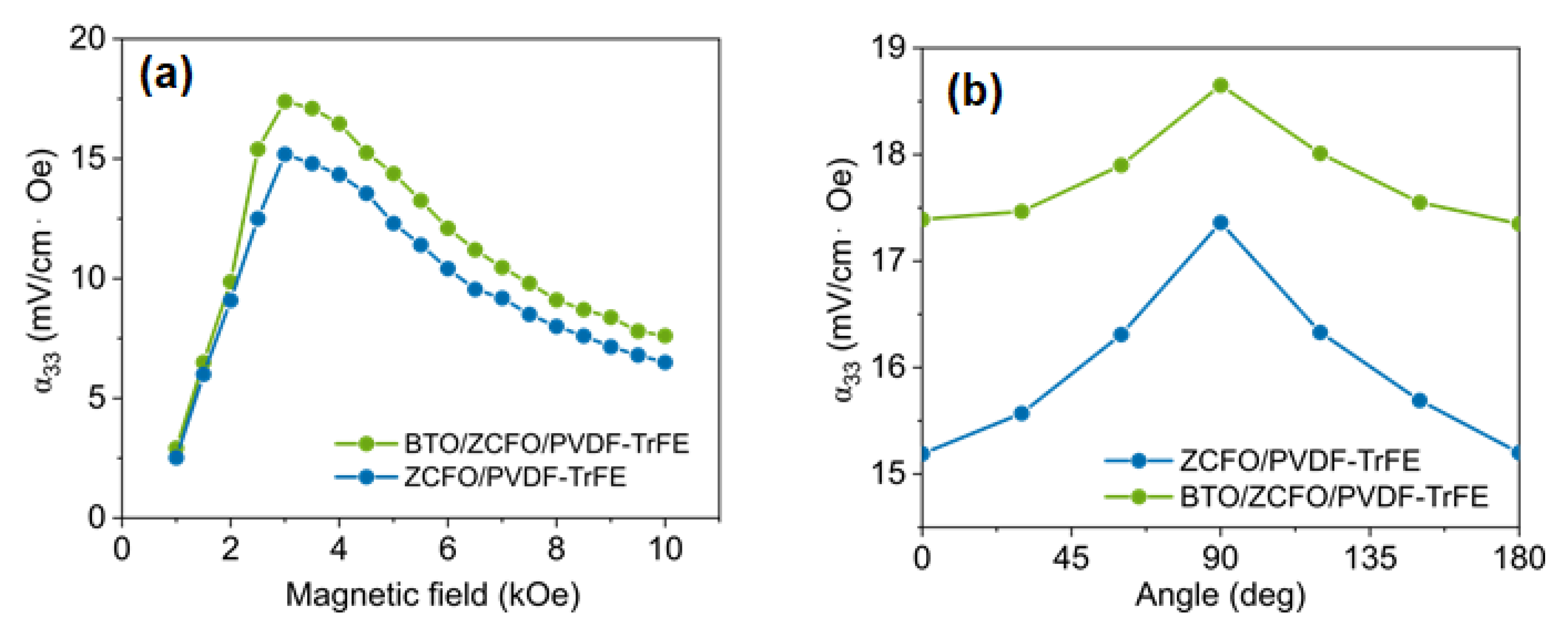

| Depth, µm | Atomic Content, % | ||||
|---|---|---|---|---|---|
| C | O | F | Fe | Co | |
| PVDF-TrFE | |||||
| 2.9 | 41 | - | 59 | - | - |
| 1.3 | 40 | - | 60 | - | - |
| 0.4 | 36 | - | 64 | - | - |
| BTO/PVDF-TrFE | |||||
| 2.9 | 45 | 1.2 | 54 | - | - |
| 1.3 | 46 | 1.4 | 53 | - | - |
| ZCFO/PVDF-TrFE | |||||
| 2.9 | 45 | 2.4 | 52 | 1.0 | 0.4 |
| 1.3 | 45 | 2.6 | 52 | 0.6 | - |
| 0.4 | 44 | 3.1 | 52 | - | - |
| BTO/ZCFO/PVDF-TrFE | |||||
| 2.9 | 52 | 6.8 | 38 | 1.5 | 0.6 |
| 1.3 | 54 | 7.3 | 37 | 1.1 | - |
| 0.4 | 56 | 10.6 | 31 | - | - |
| Sample | Filler Content, wt.% | Young’s Modulus, MPa | Mechanical Stiffness, mN/μm | |
|---|---|---|---|---|
| PVDF-TrFE | - | 0.63 | 0.027 | - |
| BTO/PVDF-TrFE | 5 | 0.65 | 0.028 | - |
| ZCFO/PVDF-TrFE | 15 | 0.3 | 0.008 | 17.4 |
| BTO/ZCFO/PVDF-TrFE | 5 (BTO) 15 (ZCFO) | 0.65 | 0.028 | 18.6 |
Publisher’s Note: MDPI stays neutral with regard to jurisdictional claims in published maps and institutional affiliations. |
© 2022 by the authors. Licensee MDPI, Basel, Switzerland. This article is an open access article distributed under the terms and conditions of the Creative Commons Attribution (CC BY) license (https://creativecommons.org/licenses/by/4.0/).
Share and Cite
Sobolev, K.; Kolesnikova, V.; Omelyanchik, A.; Alekhina, Y.; Antipova, V.; Makarova, L.; Peddis, D.; Raikher, Y.L.; Levada, K.; Amirov, A.; et al. Effect of Piezoelectric BaTiO3 Filler on Mechanical and Magnetoelectric Properties of Zn0.25Co0.75Fe2O4/PVDF-TrFE Composites. Polymers 2022, 14, 4807. https://doi.org/10.3390/polym14224807
Sobolev K, Kolesnikova V, Omelyanchik A, Alekhina Y, Antipova V, Makarova L, Peddis D, Raikher YL, Levada K, Amirov A, et al. Effect of Piezoelectric BaTiO3 Filler on Mechanical and Magnetoelectric Properties of Zn0.25Co0.75Fe2O4/PVDF-TrFE Composites. Polymers. 2022; 14(22):4807. https://doi.org/10.3390/polym14224807
Chicago/Turabian StyleSobolev, Kirill, Valeria Kolesnikova, Alexander Omelyanchik, Yulia Alekhina, Valentina Antipova, Liudmila Makarova, Davide Peddis, Yuriy L. Raikher, Katerina Levada, Abdulkarim Amirov, and et al. 2022. "Effect of Piezoelectric BaTiO3 Filler on Mechanical and Magnetoelectric Properties of Zn0.25Co0.75Fe2O4/PVDF-TrFE Composites" Polymers 14, no. 22: 4807. https://doi.org/10.3390/polym14224807
APA StyleSobolev, K., Kolesnikova, V., Omelyanchik, A., Alekhina, Y., Antipova, V., Makarova, L., Peddis, D., Raikher, Y. L., Levada, K., Amirov, A., & Rodionova, V. (2022). Effect of Piezoelectric BaTiO3 Filler on Mechanical and Magnetoelectric Properties of Zn0.25Co0.75Fe2O4/PVDF-TrFE Composites. Polymers, 14(22), 4807. https://doi.org/10.3390/polym14224807












